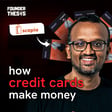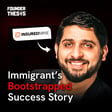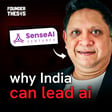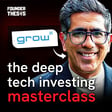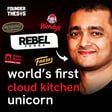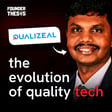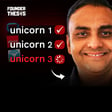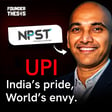Introduction to Founder Thesis Podcast
00:00:00
Speaker
Take a minute, I'm dead. You're not dead. Hello. You're not dead. This could be a great intro. Hi, I'm Akshay. Hi, this is Aurob. And you are listening to the Founder Thesis Podcast. We meet some of the most celebrated sort of founders in the country. And we want to learn how to build a unicorn.
Bhavan Patel's Early Ventures and Financial Insights
00:00:25
Speaker
So I'm Maaveen Patel, co-founder and CEO of LinkedIn.
00:00:32
Speaker
They say that some people have entrepreneurship in their blood, and Bharat Patel is surely one of them. He started his first venture when he was in his early 20s, not even two years after completing his education. After exiting the first venture, he spent a couple of years in the world of financing, and in 2014, he started up Lame Lane Club, a peer-to-peer lending platform.
00:00:57
Speaker
Bhavan was ahead of the curve in his understanding of the pain areas of the two segments, the ones who have money and the ones who need money. On the one hand, Indians are amongst the highest savers in the world and on the other hand, people who need money have great difficulty in accessing it.
00:01:14
Speaker
through banks and NBFCs due to the tedious approval process. So Bhawan is connecting both these audiences using a tech-enabled platform, allowing the people with money to earn a good return on their funds and the people who need money to get access to funds quickly. Here's Bhawan telling Akshay Dutt about this wonderful journey.
From Sports Enthusiast to Chip Design
00:01:43
Speaker
So Bhavan, tell me about growing up, Bhavan. As a kid, what were you like and what kind of environment did you grow up in? So I was always too much into the sports. So during the schooling till 12th,
00:02:00
Speaker
I was a friend in both sides, academics as well as games. So I would score first or second. Alongside I was also captaining our school football team and ball team. Up to ninth, basketball team as well. Later on, Mirahai Tutna grew newer, so I had to
00:02:24
Speaker
I'll leave that team because he required that. And I was also a state level player in all these games. Alongside, I was also up to district level player for kapati as well as volleyball. So you will always hear sports from me even today. So today also. So sports make you like sports as your occupation.
00:02:52
Speaker
I wanted to. So in fact, when I was in 10th, I got selected for a national handball team. But unfortunately, at that point in time, because my parents didn't want me to pursue during that year, and it was always a once in a lifetime opportunity because you can't get selected again and again. But I couldn't do that. But that's okay. I mean, see, it's I still enjoy that that game and I still play football very regularly.
00:03:22
Speaker
What's your parents background like both? So my parents are teacher, both of them are primary teachers. So obviously education was important growing up. Yes, absolutely. So that was focus and I think they were not wrong as well, looking at the situation in India. But yeah, that was the same. So what did you take up like science commerce?
00:03:46
Speaker
So I took up science. I wanted to get
Switch to Finance and ICICI Prudential Career
00:03:50
Speaker
into cheap designing. So... Cheap designing is a specific goal. I know it was interesting. So my mother is an avid reader. So even during my childhood days, I used to read a lot. Again in Gujarati. So we used to get literature and I was part of library groups and all.
00:04:18
Speaker
And my mom used to read a lot. So she would have all the news of the market, film industry, everything. So she inspired me to read a lot. And when I was reading about current affairs and all, what I realized is next 10-15 years are going to be into this direction.
00:04:41
Speaker
You know, chip designing is something. And during the science phase, I used to make science projects around that. So, when I worked early, around 6th or so, I made a hovercraft and when it was flying just above the floor, it was too exciting for me. So, I got excited.
00:05:10
Speaker
At that time, I had no idea what chick designer to do or how it happens. But my goal was to do it. So, please, what was your 12th job? So, after 12th, I was on track to my target to become an electronics engineer. So, I took Admissions into Electronics and Telecommunications. So, I took an Admissions and it was going on well till second year.
00:05:37
Speaker
when actual electronic subjects started and all and suddenly I realized that it's not something which I would like. Two reasons were behind it. One, there were no opportunities in India on the chip designing sector side, right? Everybody would agree to that. Even today very few. And I did not want to move out of India. My goal was very clear that, you know, Ujubigar in India,
00:06:05
Speaker
So, if there is no opportunity in India, then there is no meaning of pursuing that subject or that career. So, from third year onwards, I started thinking about what else I would be doing after engineering. And that's how I got deviated towards management side and today history side history. So, in generic about then you did an MBA straight out of engineering.
00:06:33
Speaker
Yeah, so goal was, so many life my goals, that moment I will realize what would be the next thing. So I started taking advice from my college seniors, my professors and all and all of them were on one single point. The way you are leading our annual function, the departmental functions and you keep the whole class together or not, you know, single thing.
00:07:02
Speaker
I, we think that you should pursue management and I also realize the fact that I really enjoy doing that. So that gave me an idea that, you know, I should pursue MBA. So started preparing for CAT and applied for that. And in fourth year itself, I secured the position in Kiloskulls and post engineering, I joined it immediately after that.
00:07:32
Speaker
What specialization did you take up? What was the goal at that time? See, I wanted to do it in marketing because I used to like interacting with people. I used to experiment with things.
00:07:48
Speaker
So I would love coming up with new ideas, implementing those, achieving new goals and all. So sales and marketing was something I used to like, but I used to score very, very high in finance subjects. So I was really good at numbers. So I pursued it in dual degree, marketing plus finance, almost similar credits on
00:08:14
Speaker
both the subjects. So during those days, I used to like finance. I was a topper in accounting, whereas generally, engineering student would be very vacant accounts. But I was the one who was defating even become people from SRCC also. But I used to like numbers. And over the period of last 10, 15 years,
00:08:38
Speaker
that has been part of my daily life. So marketing finance was something I pursued and started my career after that. And where did you get placed from campus?
High-Value Sales Experience and New Venture
00:08:50
Speaker
So I got my first job in ICICI Prudential. So that was the start of my journey. But very soon after that, I took up a challenge where one small startup in 2008 wanted to establish themselves in selling some
00:09:07
Speaker
fixed income related modeling services to mutual fund and banks in India. So, I technically considered that as a first job because I spent sizable chunk of my career over there and learnt a lot
00:09:22
Speaker
And what was the product that you were selling? What was the service? So it was modeling services. So when there are sizable data of different instruments available in the market, you put it together and try to come up with various analysis, stress testing, whether this company will default based on these numbers or not.
00:09:44
Speaker
in terms of securitization transaction whether the securitization deal will reach to the end goal or not. Is there any stress sign possible in between or whatever pricing is happening whether that pricing is right or not or there is a impossible improvement or looking at current pricing and possibility of default whether this transaction will be profitable or not.
00:10:07
Speaker
So, I mean, it was very specialized thing. And in India, that segment was just picking up in during 2008 night and was something very, very new to Indian market. Okay. Okay. Okay. And like, what was like, was it like high value sales? I imagine it must be a pretty high priced kind of a thing.
00:10:30
Speaker
Yeah, it was, it was quite high value sales and conversion will not be like every day you do some number of sales. So it's like sales cycle is very, very long, at least 9 to 12 months. And it's something which requires the development and, you know, involvement of many key strategic people in the bank as well as mutual fund. So very, very, very long cycle and you also required to be on tours.
00:10:57
Speaker
during those periods because they will come up with any queries and you need to have an answer to those. And what were your takeaways from this? What did you learn? Did you build any kind of playbook or a mental model? Yes, absolutely. Sales is day and night. I remember still in 2008, 31st December,
00:11:26
Speaker
I along with my boss, we were roaming on around in Nariman point. So during that period Nariman point was the hub for all the financial services company, all banks, mutual fund, right. Abhito Tharajd is to Victoria. So we were roaming and we found, so we were having tea at one of the tea stall, if you know Nariman point, there are area then, right. So we found two more guys were there and almost nobody was around. It was time of 3.34 in the evening.
00:11:54
Speaker
So we were just chit chatting. The idea was, I never got bored doing all that kind of stuff.
00:12:15
Speaker
You know, it's always exciting that you are meeting new guys, pitching them new product. When I started, so it was my first job, I did not have experience. So a couple of times the incident was like the person who is sitting opposite to you, a fund manager or general manager crazy of a bank, he's like carrying 20, 30 years of experience, very highly educated guy. You don't know what to talk, right? And in one meeting I told the guy,
00:12:54
Speaker
But point is see when you are upfront you speak whatever you are into or whatever you are selling. I think that transparency and straightforwardness helps you cracking things. So that was one of the biggest learning
00:13:12
Speaker
Second thing which I learned from founder of that company is, you know, always try to understand more and more things beyond your limits. Try to learn beyond whatever you are trying to sell. You know, those areas will help you build a repo with the people, you know, try to sell it along with some additional things. So these two things which I learned and I carry that even today.
00:13:44
Speaker
I think you then started your own thing. Yes, right. So during that period, I came across a secretization concept. So during that job, we were arranging a secretization conference. So I came across many NBFCs, bank, all the market participants. And ideally, there is a need of somebody who can help small NBFCs to raise capital through secretization.
00:14:14
Speaker
right now it is not happening because they don't know it is possible. So, if somebody will guide them in a right way, somebody can educate them, there is a possibility of market here. So, I along with one of my senior colleagues in that job, we
00:14:31
Speaker
discuss that over you know lot of weekend sessions we used to discuss about this idea. The only concern which we were facing there is both of us were too young and you know in generally this is called this can be called as investment banking services. So people will consider people with experience.
00:14:58
Speaker
But then we thought, there is no harm in experimenting. So with that process we started with it and it went well. It took around 5-6 months for us to crack the first transaction. But then we worked with 4-5 different NPFCs of different size anywhere between 100 crore AUM to 7-800 crore AUM.
00:15:23
Speaker
helped me a lot in terms of creating understanding about lending businesses in India. How microfinance works, how personal loan works, how two-wheeler works, how three-wheeler financing, commercial vehicle financing.
00:15:39
Speaker
So, that was very, very interesting period in my life. Those two, two, three years which we spent, definitely it wasn't a very smooth journey. But that journey with struggle was very, very helpful and insightful, which now it's helping me in building LinkedIn. So, eventually you had to shut it down. What happened?
00:16:07
Speaker
Suppose that I joined one of my client company, so we were facing a little bit of struggle over there and RBI norms were changing, banking norms were changing up. So both of us decided that let's do something else for a couple of years and then probably we can come together or we can continue going into our own direction. So in 2011, I joined one of my client company which was electronic opponents. So they were also going through some crisis period and
00:16:36
Speaker
We both found that, you know, let's do it together. So I set up a securitization desk for them. We did raise around 200 crore or amount through securitization over next two years. Okay. Okay. Okay. Got it. Okay. So then you joined Electronica and after that, like, you know. So Electronica was a time when, when the roots of lending club started growing up.
00:17:05
Speaker
continuous desire to find a solution to raise money from the market is when the idea of living club started coming up.
Contemplating the Lending Club Idea
00:17:14
Speaker
So what I had seen during those five, six years is that this lending companies are continuously struggling to raise capital. They are not fighting everyday fight to source more customers, but they are fighting everyday fight to raise the capital. So is there a new possible instrument
00:17:35
Speaker
where a lending company is not dependent on the banks to get their capital because that's the raw material and something else is there or can we access the public capital easily etc. So in India that concept was not
00:17:52
Speaker
very easily available because in India only big NBFCs can raise public capital like Sriram, Tata, Bajaj and all, but not for those NBFCs which are smaller. So is there any way we can come up with some new model? It's a time of technology. So we can use technology to come up with new idea. We can use technology to build very complex solutions also.
00:18:17
Speaker
So, that pushed me towards a possible solution and that solution was a P2P concept that we can open up the capital side of the lending business by getting number of investors on the platform which will invest into these borrowers and then borrow a repairs loan and that is how the ecosystem will run. So, that started. So, Electronica was in Pune. I wanted to move back to Mumbai.
00:18:42
Speaker
Because if I have to execute this plan, we'll require at least couple of co-founders and much more support system. And by being financial hub, we get resources very easily. And also the speed is much higher. So Pune is definitely a slow market.
00:19:00
Speaker
So, I came back to Mumbai, helped companies in raising capital, also started doing jobs with one NPFC. They wanted to complete the acquisition and they wanted to set up the initial business. So, I was working three days over there and three days I was working on Lending Club.
00:19:19
Speaker
So that went on for a year, year and a half kind of time period. And during that period, a Leaning Club plant was also on the track. I got the best as a co-founder. So he was also coming out of his existing startup. So timing smashed in. What is his background?
00:19:40
Speaker
Deepesh, after completion of his NIT Kurukshetra engineering, he started working with a company called Nujin Software and post that he co-founded a product with one of his colleagues in here. So that product was into a complex piping solution which was built through technology. Otherwise, earlier people used to draw those drawings on paper and
00:20:05
Speaker
It used to take a couple of months time period. So that used to happen in 36 to 48 hours on the solution which he built. So that solution was being adopted by many companies across different countries. And that was supposed to be part of one product company of France. So he was about to come out of that product because once that take over is done, that product will no longer be available to be developed by him.
00:20:35
Speaker
So that's how our timings matched. We started working together on it. Worked four, five, six months. We launched the first version of the platform in mid of 2015. Isn't this like an NBST?
00:20:59
Speaker
So, when we launched, now it is regulated. Now, RBI has NBFC B2P regulations, where you have to take prior approval before you start the business. But in 2015, it wasn't there. Okay. And were there other companies doing this, like Ustaimpe as an alternative peer-to-peer lending case? So, we built this first platform, Ustaimpe or company launch.
00:21:26
Speaker
So, looking at that, we also got, I mean both the feelings. So that we are also, you know, maybe first two players. What was the other company? Are they still around? Yeah, it's fair sense. So they are still around.
00:21:52
Speaker
And so all your prior experience was like in high value lending and I don't think peer-to-peer lending is high value. Peer-to-peer lending is typically like much smaller ticket size till they use Otheogu. So, see, I worked with around 6-7 different NBIRC in the consultant role as well as an employee. Out of them, Electronica was very high value. A raised of them were like ticket size of 80,000 1 lakh rupees.
00:22:21
Speaker
two-wheeler through three-wheeler or microfinance or you know, some other kind of credit lines. So they were all around 1 lakh rupees and that we generally considered as a small ticket loan only. And peer-to-peer lending, what is the average ticket size like? So for us, the average ticket size to business loan to businesses is around 50,000 rupees and to salary is around 15,000 rupees. Okay, okay, okay.
00:22:49
Speaker
And like, you know, what is it largely like business, like business owners who take loans? Bigger chunk of loan takers. Bigger chunk is business because that the requirement is more frequent and much larger compared to our salary customers, right? Because salary side it is for consumption.
00:23:14
Speaker
And for business side, it is for income generation. Yeah, like inventory or working capital. Absolutely. Absolutely. So there the demand is definitely much higher. So around 70, 75% of business comes through that segment and 25, 30% from selling side. So why would a business go for a peer to peer lending platform instead of a bank? So they don't go just for peer to peer lending platform. They go for a lender.
00:23:43
Speaker
right the most important part is a capital and second is timely capital.
00:23:49
Speaker
So if somebody is giving you capital after 15 days, but you require it today, I mean, then it doesn't make any sense, right? And especially in business, timings are very important. I mean, whether it is business or for salary people, timing is important. If somebody is admitted to hospital or you have to pay your kids fees, I mean, you can't wait for 10 days, 15 days. So capital and timing both are important. And for them, we are aligned.
00:24:18
Speaker
It doesn't matter whether it is a P2P landing platform or it's a NPRC landing platform. How does that matter? Okay. And why would people give money to a P2P landing platform? So for the loan taker, the value is speed, right? But the quick approval, I'm guessing, I'm guessing most of the reasons. But the reason is that you have to do that.
00:24:46
Speaker
But if you invest in the primary reason, what will happen? It will return on investment. Perfect. So people get sizeable return on the platform and that's what makes an interesting instrument for them. It will return on investment compared to, say, like, F.D., I think it will charge a lot of people. It will charge a lot of people.
00:25:12
Speaker
So in the club, historically, we have been delivering anywhere between 12 to 15 percentage. And now also we target to have anywhere between 11 to 13 percentage returns for the lenders. And who underwrites the loans? So it's a mixed underwriting. It's not as straightforward as how it happens with any other lender like NBSM bank because they have their own capital right
00:25:39
Speaker
So, here the assessment of the customer is done by the platform, it is approved by the platform and then lender takes the final decision to invest money.
00:25:48
Speaker
So, lender can set their auto-image parameters. So, based on whatever parameter they have decided, system will keep matching them with the relevant borrowers. So, if you meant to say underwriting by deciding whether to give money or not, how much, then that right is always in the hand of lenders. But if it is related to approving a loan, then it is in hand of the platform.
00:26:15
Speaker
So what is your like you know, risk control, like in short cut it's a genuine logo colon approval, right? There are many things see today in digital era, you can understand anybody from their digital footprints, from their mobile phones, from the data which you can get from other third parties, like your bank statement or credit card. So considering all these different
00:26:51
Speaker
Whether this borrower will repay that loan or not, if repayment probability has some default probability, then accordingly your loan rate will vary. So, based on the risk assessment of the customer, we approve, disapprove or approve with different pricing on the platform. So, what all data do you ask lenders to provide like to do the risk assessment?
00:27:05
Speaker
data points, we try to understand your intention as a borrower. So, based on that understanding of the borrower
00:27:20
Speaker
You mean to say Borrower, right? Sorry, Borrower, I meant Borrower. So Borrower, some data point Borrower provides us and a lot of data point we access directly. So as I say, digital footprint, right? So that is already left by the Borrower. Like what? Like Facebook profile, what does that mean? I mean, that's the old time when people used to talk about Facebook data and all. One, they don't share too many things now.
00:27:48
Speaker
Second, I mean it is not required, it is not essential just to understand a customer from their social media profiling, right. It is important to understand what actually they do. On social media people can fake out lot of information, right. So, it is not the only one thing. We used lot of secondary data points which customer otherwise cannot fake those data points, right, like the kind of transactions they are doing in their bank accounts.
00:28:18
Speaker
or the kind of the way they are using their mobile phone, the different kind of mobile apps they are using, the time they are spending on the mobile, the kind of an instrument they are using it, right. Over last 30 days, what a different website you have visited, correct. All these information are very fruitful and that helps us build thesis around a borrower that what type of person you are, right. So, see traditionally also if you have to give money to somebody,
00:28:49
Speaker
or if you have to give loan to somebody, you try to understand the person, right?
00:29:14
Speaker
If you like to hear stories of founders then we have tons of great stories from entrepreneurs who have built billion dollar businesses. Just search for the founder thesis podcast on any audio streaming app like Spotify, Ghana, Apple Podcasts and subscribe to the show.
00:29:44
Speaker
So, for example, how do you play games every time? Is it like a high-risk category? How does the digital footprint work? I can give you an idea. Nothing is bad as far as a person is disciplined around the finances. You might be spending a couple of hours every day on PUBG, but still you are earning a sizable salary every month.
00:30:14
Speaker
and you are very disciplined around your repayments you have been serving your EMI's right. So, definitely you are a good person and you know how to manage your lab duties as well.
00:30:25
Speaker
Oh, timely repayment, like that you will come to know through like, for late payment, like that would be the data bank statement. So it's not so as I said, see, when you know that what things are being assessed, but when they don't know,
00:31:03
Speaker
So basically like the mobile app which they install so in that app they have to give permission so that the app can read the SMS and other things and then
00:31:13
Speaker
draw a picture of the credit worthiness of the person. So that's one part where bank accounts say, you know, data fetch, credit bureau, which third parties? Bank accounts can say data fetch. Is there like an API integration? It's API based system. Right. Well, they can authorize you to. Correct. See, if you're a genuine customer, you will do it. Right.
00:31:41
Speaker
For people who are not genuine and they want to do some bad things with the system, then only they will not authorize all those parts. And public sector banks like to fetch private sector banks. 90% customers will have their salary bank account as a private bank account, including SBI, as a BSP. Race to all banks will fall within those 10% bracket.
Matching Borrowers and Lenders: Tech and Timing
00:32:14
Speaker
you have today, how did this evolve? How did that process become better over time? So it was very basic when we launched it. Over the period of time it got built and now it is moving towards betterment day by day. So it takes time and especially in landing business, it can't happen overnight.
00:32:41
Speaker
You may have money to lend. That can happen overnight. But you can't create customer behavioral pattern overnight. So it takes time and time to experience that. And according to that, you build your system. So every time there's a default to apostate the behavior. Correct. That adds to your algorithm. Absolutely. Okay, so how is your NPIV like, you know, how is it evolved like defaulting percentage?
00:33:10
Speaker
So it has been moving between 3 percentage to 6 percentage over last 6 years. So based on certain situation there could be stress but it's stabilizing around 4 and half 5 percentage.
00:33:24
Speaker
Okay. And how does this compare? Like Baki NBFCs make it out their default percentage. So generally, unsecured portfolio can default rates 4 to 5% right there. But difference here is we don't need to write off anything. Whereas in case of a normal bank or NBFC, they can write it off against that available capital. Once they write it off.
00:33:52
Speaker
here because you are not the lender, you are just the intermediary who's connecting. Correct. Right. Okay. Okay. So Yape default is totally like the hit is totally to the person who's giving the fund. Correct. Right. But after default, our fees also they make hints of returns. So it doesn't affect because default is always a relative term, which should be coined along with the net returns. Right. So as far as that is achieved,
00:34:22
Speaker
It's good enough. I mean, net return would make sense. He would be in a like a net loss. Yes. So generally we suggest our customers to start investing at least with 25,000, 50,000 rupees. Right. So one of the base principle of P2P landing is a diversification.
00:34:51
Speaker
So let's say when a customer invests 1 lakh rupees, that 1 lakh rupee is given to 200, 300 different borrowers. And our optimization algorithms are also built according to that.
00:35:08
Speaker
that you know how to achieve the maximum diversification by keeping different risk categories to a single lender so that you know everything is diversified in a proper way so that lender is achieving that 10 to 12 percentage return target. Got it. So this is actually not like one to one but it's like many to many there's many borrowers many lenders
00:35:34
Speaker
And lenders are split among many borrowers and they borrow many lenders. And is this for like long term investment option for people in short term?
00:35:51
Speaker
Let's say is this the right place for me to put money then? No, it is not. You should at least keep money for a year to see real good results. So we don't suggest that to keep this money with P2B platform for a very short period of time.
00:36:08
Speaker
So, because in P2P, our optimization algorithms are optimizing your portfolio based on the tenure. So, when you are saying that I will remain invested for 12 months, the algorithms are reinvesting based on that 12 months strategy. If you disturb that in between, then there is a chance that you may lose out some of the principle or your returns may not be adequate. So, you come up with 12 months time period and keep it for 12 months. Suppose that you take it out.
00:36:38
Speaker
So what is the flow for an investor? If you can just tell me the flow.
00:36:54
Speaker
So investor has to open the Lenden account by providing basic advice information right. Ekbar bohogia once account is opened on our system, he can transfer money let's say he transferred 1 lakh rupees and set his auto invest parameters that this is the type of borrower I want to invest into. Based on that system will keep investing and then later on reinvesting money to those borrower.
00:37:27
Speaker
He loses some money as well.
00:37:34
Speaker
No, not necessary he will lose money but there is a probability because system is designed to create that 10 to 12 percentage return over 12 months. There is a probability not necessary. But you always have a right to stop it in between.
00:37:59
Speaker
You won like 4,000. Correct. Okay, correct. So how do you handle it? How do you handle it? How do you handle it?
00:38:19
Speaker
So, generally, if you are matching 1 month loan, let's say you want to take out money today itself, then you can stop reinvestment. So, whatever money will come in terms of EMA, that will keep accumulating and you can take that money out. What is the flow for a borrower?
00:38:45
Speaker
So again, borrower has to complete his loan application. So he has to provide basic KYC and then there are certain authorizations, just a bank account statement. In back end, my system takes out those digital footprints, his metadata, etc. And system will automatically keep reading those data points and creating their behavioral analysis. Once borrower completes the loan application, he also accepts the loan agreement.
00:39:14
Speaker
By the time loan agreement is accepted, my system will have all the data ready, all the understanding ready. It will underwrite the loan and decide whether to give loan or not. And within couple of minutes, system will throw the result to the borrower. So, the result will be like kithna loan maximum and kiss percentage, like that will be the result. Correct, correct. And over time that limit can increase or the percentage can come down or go up. Absolutely.
00:39:43
Speaker
like set a duration and an amount and then I can get the loan to my account. Once the system gives an approval, you can take out money to your bank account anytime because we have already verified your bank account. So we have all this information.
00:40:04
Speaker
And if there is a default over collections, what do you do for collections then? So, for that also we have tag based processes. So, generally we collect 94-95 percentage of money within the same month, whatever borrowers are unable to pay due to whatever reasons, they subsequently paid. So, we have full-fledged collection mechanism, collection team, legal collection mechanism, everything is in place.
00:40:30
Speaker
The lender doesn't bear the cost for that, like collections key cost. No, no, everything is on the platform. So we provide that as a service to our lenders, because individual lender can't do anything, right? I mean, it's difficult for him. And as a platform, we know what to be done, how to be done. So we take care of that part.
00:40:49
Speaker
But if there is no extra charge for collection, that is part of the platform cost only, basically. Correct, correct. And what is the platform cost? How do you earn? So we generally charge from landlord 2 to 2 and a half percentage of fees. So that is the fee on the investment.
00:41:11
Speaker
And that covers the cost of collection, the cost of tech, the cost of marketing. And how do you acquire customers like both sides, like the lenders and the borrowers? How do you acquire them?
00:41:24
Speaker
Again, all digital channels, partnership route, so all various type of, you know, possible routes like affiliates or performance marketing, everything. And a lot of customer comes to us through referral route as well, on borrowed as well as lender side, because they see the effectiveness of the platform. And then we do source users through partnerships as well. What kind of partnership? We have partnership with companies like
00:41:50
Speaker
Google Pay, so we are available on Google Pay, borrower can find us. So these are all digital partnerships, which we have, and customers can see us. So they're all come to us through them. Okay, okay. So when you launched, you know, so tell me about the like, like what kind of numbers wise growth you had. So you launched somewhere in 15, right?
00:42:21
Speaker
15, what kind of numbers did you have? What was the corpus that you collected in that year? And how did that grow?
00:42:33
Speaker
So if you look at last three numbers, those will be more accurate. Last three years, FY19, we did disburse around 13 crore worth of load. In FY20, we did disburse around 55 crores worth of load. And FY21, we disburse 500 crore plus worth of loads. Wow, that batch of growth. Yeah, so there has been exponential growth across all these years. Okay.
00:43:00
Speaker
So, like how did this jump happen? Like this is a pretty big jump, 21 keys. Yeah, now also you will see some big jump. How much are you expecting this year? Like roughly. This year we are targeting to disburse around 1200 crore worth of loan through that. Wow, okay, okay. This year meaning ending 31st March 2022.
00:43:25
Speaker
Yeah, correct. Okay, okay. So how does that compare to other players like P2P lending, how much do they disburse? If you have like... Public domain data is not available. So it's difficult to comment. But if you look at monthly disbursement volumes, then we are very, very large and very, very significant here right now.
00:43:52
Speaker
Well, who would be as large as you or larger than you? Like where do you rank? I think on monthly numbers, we would be number one. Okay. And who are like number two, three, like who are the close competitors? So some of our competitors are fair side or fancy. So there are two, three other players as a significant business. And do you have separate segments of customers that you target? It's the same segment only, like
00:44:21
Speaker
Is there like a specialized segmentation? Ours is very, very differentiated product. So none of the P2B platform offers it to product which we offer. Either we talk about Insta money, which is for the salaried customers or merchant loan solution, which is for businesses. Both are very differently curated and built products.
00:44:46
Speaker
And the targeting is also very focused. In what way are they different? So like majority of the P2Ps are targeting customers for loan worth of lakh or more. Whereas our targeting is only for some thousands. So it's a very small ticket size, high churning loan product. On merchant side also we focus only on ticket size like 50,000 rupees.
00:45:11
Speaker
And this would be short term, like one to three months, three months, four months you pay that loan and take another loan if you're required. So very clearly curated product and that's not something which other players are operating in.
00:45:27
Speaker
The other players have bigger ticket size lows. Bigger ticket size and I think they are offering more on the lines of other NPFCs rather than coming up with product because this product has its own pros and cons.
00:45:44
Speaker
high churning but at the same time the you have to take care of lot of aspect like on a smaller ticket size you are running is low whether you make that loan profitable or not collection cost is high in terms of percentage so whether you will make money on collection services or not. So it has attached some cons as well but over the period of time we have overcome those and we know how to operate.
00:46:09
Speaker
So how do you keep your collection cost low? You said it's all tech based. So what is your collection process like? So whatever people can do, technology can do. So we keep thinking and keep asking ourselves question that if this process is manpower oriented, how can we make it automated? So is there a way of making calls to customer where you don't require manpower? Is there a way to make follow ups to customers where you don't require manpower?
00:46:37
Speaker
Slowly, gradually, now we have reached to the system where even 70% of my collections are completely automated. Give me an example.
00:46:49
Speaker
Nowadays, you have technology that, you know, I mean, whatever customer will say, your system can react exactly to that question or that query in a human language, right? And you can set a lot of preferential things that what time customer will pick up a loan? What is his preferred language? I mean, if I'm calling on Sunday, what should be my preference of human language?
00:47:20
Speaker
Yes, yes. It's through what the language is the way any human speaks. Is this an off-the-shelf thing that you can, or did you build these bots? But look, you know, this sounds like very complex technology. See, today, ingredients are available. What is available, sorry?
00:47:43
Speaker
All ingredients are available in the market, right? And you have YouTube to know the recipe as well. It's a question how you will make that recipe realizing. So we have made it a reality. You get like regional language compatible bots that you can integrate. So you're calling basically you have completely made it into a
00:48:26
Speaker
Okay. And what else besides calling, is there also like WhatsApp reminders and all of that? That's part of the journey. So other channels. That's relatively easy to automate that. That has been automated since ages, but some new things are definitely there and we keep implementing those. So keep experimenting. Some or the other thing will work and you see real good results.
00:48:37
Speaker
There is no need for humans to call. Almost 70-80% through watts. Okay.
00:48:52
Speaker
So tell me about your fundraise journey. Did you raise funds that time or was it bootstrapped initially?
Fundraising and Profitability Journey
00:49:01
Speaker
Initially it was bootstrapped and when we launched we raised a small amount of capital through friends and family network so that we can use that money towards initial operations. So that was done and subsequently we raised in a couple of rounds under SEAD and pre-series.
00:49:20
Speaker
So, we raised one and a half million dollars worth of capital so far that we became profitable and then it wasn't too much pushy thing that we have to raise capital to grow the business. So, as of now you don't need external funding but you are generating enough cash. Yeah, so we are profitable and we don't need cash to run the operations. Amazing, okay. So, no plans to raise more money now?
00:49:49
Speaker
I would not say so. That could be planned in future, but a point is business doesn't require money to run the operations. So you are free to scale up the operation up to any extent. What is your customer acquisition cost like? How does it cost you for each customer you acquire?
00:50:15
Speaker
I can't comment exactly on the amounts and all but it varies channel to channel and one of our strong point is the cost of acquisition. So, we have developed channels where cost of acquisition is very very reasonable and we still make money on each and every customer coming to us. Tell me about this like you know how did you bring down the customer acquisition costs.
00:50:39
Speaker
So keep looking into the cost which are coming up to you, the channels which you are using to source the customers and keep reinventing the way you are doing it.
00:50:57
Speaker
whatever, but you should not do only one type of ads. You may have to experiment it with five more things. So keep experimenting till the time you reach to the level where things are acceptable or, you know, very, very effective. And again, all that comes up, I mean, top to bottom. So the way push comes from top, the team members also work accordingly and they also come up with more ideas to keep it.
00:51:27
Speaker
So what are like the best channels that you have found?
00:51:32
Speaker
All channels are good. So at different point in time, different things work. Do you have any tips for other startup founders in terms of like customer acquisition? Oh, there are so many digital marketing advisors are there. A lot of knowledge is available. They can do it. So one thing which will work for us may not work for others.
00:52:07
Speaker
And what is like your, you know, vision for Lane Lane Club, like a couple of years down the line, do you have some concrete goals to milestones that you are chasing? See, we want to be one of the top 10 lender by 2030. So we are on track to that and we believe that
00:52:26
Speaker
Top 10 lenders across all segments yeah top 10 and P2P like top 10 lenders across all the segments. So, we would we should be among a few banks and private lenders right and PFCs. So, that is the idea and that is the reason which we are taking up and we believe that it is possible because the revolution which we are coming up with in terms of accessing the capital in the market and
00:52:52
Speaker
taking the loan product to the end mile customer whom everybody was denying. So, we believe it is possible and year over year we are reaching nearer to that target. So, top 10 means what like 10,000 crore plus kind of a.
Regulatory Landscape and RBI's Role
00:53:12
Speaker
Every year we will have to disburse at least 15 to 20,000 crore worth of homes.
00:53:22
Speaker
Like how has the regulatory landscape evolved? So how has that evolved?
00:53:33
Speaker
So that time regulations were not there but Tarbia got into conversation with players at that time at very early stage and the idea was to regulate at a right time so that the wrong practices can be avoided and sector can get a boost in terms of what to be done, what not to be done and
00:53:54
Speaker
legal confidence of the participants, investors as well as borrowers. So RBI I think came up very, very rightly in terms of timing when they announced the regulations in October 2017. And subsequently they modified it little bit as and when they saw this source of scope that you know this is something should be changed so that a sector can flourish and they can be
00:54:20
Speaker
one of the mainstream lander in the country and you see the result today. So I believe they are bullish and they have recognized the importance of P2P landing and if that structural support will be there in the same optimism, I believe that within next five years RBI will see real good result and we will be able to demonstrate it to the government as well as RBI.
00:54:45
Speaker
What are the regulations as of late like broad summary like requirements? So, it is similar to what NBFC regulation says. So, there are certain fit and proper guidelines for the directors as well as management. You have to have two controllers of need of one to start this business. You have to have certain technological requirement to match with and submit that to RBI.
00:55:10
Speaker
You have to keep conducting certain technological audits time to time. You have to follow the payment mechanism which RBI has described in their regulations. And then there are certain operational guidelines on who can become lender, how much amount they can lend. Okay, got it. Cool. So there was this controversy of these Chinese lending apps. I don't know if you are aware, like there were these apps which were
00:55:39
Speaker
doing payday loans and stuff like that what was that about like and did that affect you in any way no it hasn't affected because see the practices which they were following they were there in market for a couple of years and see in lending if you i mean like can you explain that for our listeners
00:56:02
Speaker
So the controversy was created because majority of the Chinese apps were dispersing loan by taking very few data points without understanding what was in a right way, without even knowing the customer through right KYC processes. So the issue was what they will do is they will give you some thousand worth of loans by just taking your other guard number and they will access your contact details and then
00:56:30
Speaker
When you don't pay or you are unable to pay, they will come very aggressively. And within four or five days of delaying the loan, they will start reaching out to your contact details or they will start behaving. They will call your employer and everything. So see, different things are needed at right time. You can't reach out to references also within two or five days time period. People require time. And specifically when you don't know your customers,
00:56:59
Speaker
I mean you start following the same process for each and every person. When you know your customer, we believe that our customer delays don't mean there is a genuine reason. So there are certain slabs, there are certain time period which we provide to them. If they don't pay within those time period, then only the next step starts.
00:57:16
Speaker
which wasn't the case and they were following very, very bad practices in terms of collection mechanisms. So some borrower was under tremendous pressure in committed suicide and then the whole idea got triggered that how people, so many lending apps are lending money without approval of the RBI.
00:57:35
Speaker
Then I think there were some instructions given to the Google Play Store as well. So they also started validating the licenses of the apps which are available and landing on the platform. So all that practice started and I think now it is much better. Majority of those apps have gone away now.
00:57:57
Speaker
There could be some which might have gone blindfolded or something. But now it is cleared and it's good for the ecosystem as well. You know that it happened so early because when they become too big and so many bad practices are going up, that will spoil the whole industry itself. Right, right. Okay. So how big is your team now, like Linden Club as an organization? We are now 75 people.
00:58:31
Speaker
So around 1.30 is in tech, more than 1.30, around 40% is in tech and product team and remaining across different teams. Operations, credit, risk, marketing, alliances, customer support. Okay. Customer support for the lenders. They could cook a problem only a year. Lenders as well as borrowers if they are facing some technical challenges.
Closing Remarks and Call to Action
00:58:58
Speaker
So that was Bhawan talking about how he is scaling up Lane Dane Club to be the most preferred P2P investment platform. Do download the Lane Dane Club app on Play Store or App Store if you are looking to earn inflation beating returns on your invested money.
00:59:18
Speaker
If you like the Founder Thesis Podcast, then do check out our other shows on subjects like Marketing, Technology, Career Advice, Books and Drama. Visit thebotium.in that is t-h-e-p-o-d-i-u-m.in for a complete list of all our shows.
00:59:37
Speaker
This episode of Founder Thesis Podcast is brought to you by Long Haul Ventures. Long Haul Ventures is the long-haul partner for founders and startups that are building for the long haul. More about them is at www.longhaulventures.com.

